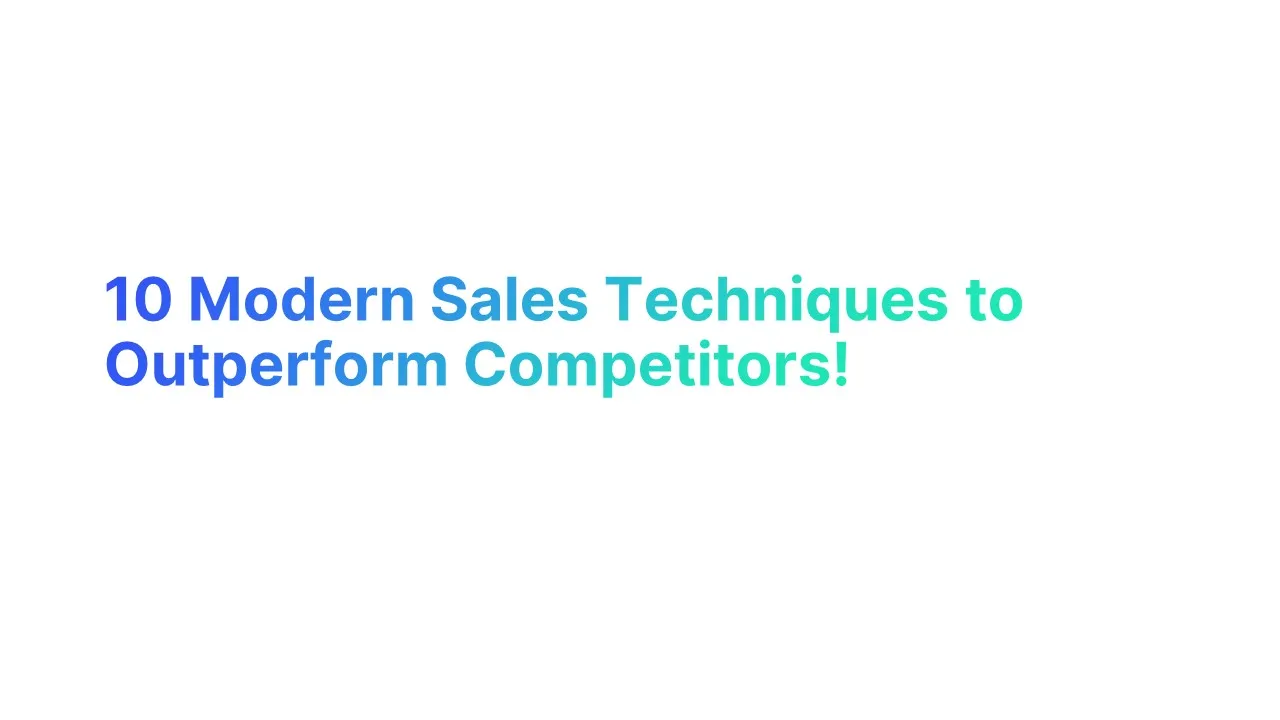Introduction to Modern Sales Techniques

What Are Modern Sales Techniques?
Modern sales approaches are advanced strategies that leverage the latest technological advancements and consumer behavior insights to optimize the sales process.
- Data-Driven Sales: Companies that use data-driven insights see a 15-20% increase in sales productivity.
- Social Selling: Salespeople who leverage social selling have a 51% higher chance of achieving their sales conversation.
- CRM Usage: CRM applications can increase sales conversion rates by up to 300%.
- Content Marketing: Businesses that adopt content marketing experience 6 times higher conversion rates compared to non-adopters.
- Automation: Sales automation can boost productivity by up to 14.5% and reduce marketing overheads by 12.2%.
Modern Sales vs Traditional Sales Approach
10 Modern Sales Techniques to Use in 2024

Here are 10 innovative and intelligent modern sales techniques for 2024. These techniques are designed to leverage modern technologies and strategies that move beyond traditional sales approaches:
1. Personalized Outreach
Personalized outreach involves tailoring communication and sales efforts to individual prospects based on their specific needs and behavior. This technique leverages data-driven insights to create more meaningful interactions.
How it Helps Achieve Sales Success:
- Increases engagement rates: Personalized emails have an open rate 29% higher than non-personalized ones.
- Enhances customer loyalty by showing that the brand values the individual.
Steps to Achieve Success:
- Gather Data: Use CRM and data analytics tools to collect detailed information about potential customers.
- Segmentation: Categorize prospects based on demographics, buying behavior, and engagement history.
- Customized Communication: Develop targeted messages that address the specific needs and interests of each segment.
- Feedback Loop: Continuously gather feedback and refine approaches based on what works best for different segments.
2. Social Selling
Social selling utilizes social media platforms to directly connect with and sell to customers. It's more than just posting on social media; it involves engaging with potential customers by responding to their queries and participating in discussions.
How it Helps Achieve Sales Success:
- Broadens reach and builds a stronger digital presence.
- Reports show that 78% of salespeople using social selling outsell their peers who don’t.
Steps to Achieve Success:
- Profile Optimization: Ensure all social media profiles are professional and brand-aligned.
- Content Strategy: Regularly post valuable content that is relevant to the target audience.
- Engage Actively: Respond to comments, messages, and engage with other users’ content.
- Monitor Insights: Use social media analytics to track engagement and adjust strategies as needed.
3. Value-Based Selling
Value-based selling focuses on highlighting the value that a product or service will add to the customer’s business or life, rather than just selling the product or service itself. This approach requires understanding the customer's core needs and demonstrating how those needs can be met.
How it Helps Achieve Sales Success:
- Shifts the focus from price to value, potentially increasing both customer satisfaction and the likelihood of a sale.
- Studies show that customers are 4 times more likely to purchase when the discussion centers on value rather than price.
Steps to Achieve Success:
- Identify Key Benefits: Clearly define how your product or service solves problems or improves the customer’s situation.
- Tailor the Pitch: Customize your sales pitch to emphasize the direct benefits and ROI for the prospect.
- Educational Content: Provide case studies, testimonials, and data-backed evidence to support your value propositions.
- Follow-Up: Use follow-up discussions to reinforce the value delivered and ensure customer satisfaction.
4. Consultative Selling
Consultative selling is a sales technique where the salesperson acts more as an advisor than a traditional sales representative. This approach focuses on understanding customer problems and needs to provide tailored solutions.
How it Helps Achieve Sales Success:
- Builds deeper customer relationships and trust, leading to higher customer retention rates.
- Facilitates higher conversion rates as recommendations are highly customized.
Steps to Achieve Success:
- Needs Assessment: Conduct assessments to understand the challenges and goals of each potential customer.
- Solution Mapping: Align your product or service features as solutions to the customer’s problems.
- Educate and Advise: Provide insights and advice that add value beyond the immediate sale.
- Continuous Support: Offer ongoing support and check-ins to adapt solutions as the customer's needs evolve.
5. Storytelling
Storytelling in sales involves crafting compelling narratives about your products or services, illustrating their benefits and the value they’ve provided to other customers. This technique engages customers emotionally, making it easier for them to connect with your brand.
How it Helps Achieve Sales Success:
- Increases memorability of the product or service as stories are 22% more memorable than facts alone.
- Enhances persuasion, helping to convert more leads into sales.
Steps to Achieve Success:
- Collect Stories: Gather testimonials and case studies from satisfied customers.
- Craft Engaging Narratives: Develop stories that showcase the challenges, solutions, and benefits experienced by real users.
- Integrate Across Touchpoints: Use these stories in sales pitches, on social media platforms, and during customer interactions.
- Train Sales Team: Ensure your sales team can effectively tell these stories in a way that resonates with potential customers.
6. Multi-Channel Engagement
Multi-channel engagement involves interacting with potential customers across various channels and platforms, including online, in-person, and over the phone, to provide a seamless customer experience.
How it Helps Achieve Sales Success:
- Reaches customers at multiple touchpoints, increasing the visibility and accessibility of your brand.
- Data shows that companies using three or more channels in their marketing saw a 287% higher purchase rate than those using a single-channel campaign.
Steps to Achieve Success:
- Identify Key Channels: Determine where your target customers are most active and likely to engage.
- Create Consistent Messaging: Ensure that your brand message is unified across all channels for a cohesive brand experience.
- Leverage Technology: Use CRM systems to track interactions and gather data across channels to better understand customer behaviors.
- Optimize and Iterate: Continuously analyze performance across channels and make adjustments to strategies as necessary.
7. Sales Automation
Sales automation involves using software to automate various sales tasks, reducing the workload for sales teams and increasing efficiency. This technology streamlines everything from lead tracking to customer follow-up.
How it Helps Achieve Sales Success:
- Enhances productivity by automating routine tasks, allowing sales professionals to focus on closing deals.
- Improves accuracy in data management and customer interactions.
Steps to Achieve Success:
- Implement Automation Tools: Choose software that integrates seamlessly with your current systems.
- Customize Workflows: Set up automation for repetitive tasks such as email follow-ups and lead scoring.
- Train Your Team: Ensure all sales team members are proficient in using automation tools.
- Monitor and Optimize: Continuously analyze the effectiveness of automation and make adjustments as needed.
8. Customer-Centric Approach
A customer-centric approach means prioritizing the needs and experiences of the customer throughout the buying process. This strategy is fundamental in building long-term relationships with prospective customers.
How it Helps Achieve Sales Success:
- Increases customer loyalty and lifetime value by providing personalized experiences.
- Drives referrals and positive reviews, which can lead to new business.
Steps to Achieve Success:
- Understand Customer Needs: Conduct detailed market research to understand the challenges and desires of your target demographic.
- Tailor Interactions: Customize communication and solutions to meet the unique needs of each customer.
- Feedback Loop: Regularly collect and act on customer feedback to improve service and products.
- Empower Customers: Provide resources and tools that help customers make informed decisions.
9. Video Selling
Video selling incorporates the use of video in various stages of the sales process, from product demonstrations to personalized sales pitches. It is a powerful tool for engaging and capturing the attention of buyers.
How it Helps Achieve Sales Success:
- Enhances the buyer's journey by providing a dynamic way to present information and demonstrate products.
- Increases engagement rates, as customers are more likely to watch a video than read a text-based email or document.
Steps to Achieve Success:
- Create High-Quality Content: Produce clear, professional videos that showcase your products or services effectively.
- Personalize Videos: Tailor video messages for major account sales strategy to resonate with key stakeholders.
- Distribute Strategically: Use multiple channels to share your videos, including email, social media, and your website.
- Analyze Engagement: Track how your videos perform and use insights to refine your approach.
10. Sales Process Gamification
Gamification of the sales process involves applying game-design elements in non-game contexts to motivate and enhance the performance of sales organizations. It's a creative way to boost morale and drive sales.
How it Helps Achieve Sales Success:
- Motivates sales teams through competition and rewards, leading to increased productivity.
- Makes the sales process more engaging and enjoyable, which can reduce turnover and improve team cohesion.
Steps to Achieve Success:
- Define Clear Objectives: Establish what behaviors or outcomes you want to encourage through gamification.
- Implement Reward Systems: Create a system of points, badges, and leaderboards to track and reward progress.
- Communicate Goals and Benefits: Ensure that all team members understand how the gamification system works and what they stand to gain.
- Gather Feedback and Adjust: Regularly collect team feedback on the gamification elements and adjust the system to better meet their needs and preferences.
How to Optimize Sales Process with Modern Techniques

Optimizing the sales process is critical for achieving sustainable growth and staying competitive. Modern techniques leverage technology, data, and innovative strategies to streamline sales workflows, improve efficiency, and enhance customer experiences.
Here's an in-depth look at how to optimize your sales process with contemporary methods:
1. Implement CRM Systems
Customer Relationship Management (CRM) systems like Salesforce, HubSpot, or Zoho CRM are essential tools for managing customer interactions, tracking sales activities, and analyzing data. CRMs help sales teams:
- Organize customer data: Centralize information about leads and customers, making it easily accessible and actionable.
- Automate tasks: Schedule follow-ups, send automated emails, and set reminders, freeing up time for sales reps to focus on selling.
- Track performance: Monitor key metrics such as conversion rates, sales cycle length, and pipeline stages to identify bottlenecks and opportunities for improvement.
2. Leverage Sales Enablement Tools
Sales enablement tools provide resources and training to sales teams to improve their efficiency and effectiveness. Examples include:
- Content management systems: Store and manage sales collateral, presentations, and case studies in a centralized repository.
- Training platforms: Offer ongoing training and development programs to keep the sales team updated on the latest techniques and product knowledge.
- Communication tools: Use tools like Slack, Microsoft Teams, or Zoom for seamless communication and collaboration within the sales team and with prospects.
3. Utilize Data Analytics and AI
Data analytics and artificial intelligence (AI) can transform raw data into actionable insights, helping sales teams make informed decisions. Techniques include:
- Predictive analytics: Analyze historical data to forecast future sales trends and identify high-potential leads.
- Lead scoring: Use AI algorithms to assign scores to leads based on their likelihood to convert, allowing sales reps to prioritize their efforts.
- Sales forecasting: Improve accuracy in predicting revenue by analyzing patterns and trends in sales data.
4. Adopt Marketing Automation
Marketing automation platforms like Marketo, Pardot, or Mailchimp can streamline and enhance marketing efforts, leading to better-aligned sales and marketing teams. Benefits include:
- Lead nurturing: Automate email campaigns to nurture leads through personalized content and timely follow-ups.
- Behavior tracking: Monitor how prospects interact with your website, emails, and other content to tailor your approach based on their interests.
- Integration with CRM: Seamlessly sync data between marketing and sales platforms to ensure both teams are working with the same information.
5. Enhance Customer Engagement with Personalization
Personalized experiences can significantly impact customer satisfaction and conversion rates. Techniques for personalization include:
- Customized communication: Tailor emails, messages, and presentations to address the specific needs and preferences of each prospect.
- Dynamic content: Use data-driven insights to deliver relevant content to different audience segments.
- Customer journey mapping: Understand and anticipate customer needs at various stages of the buying process to provide timely and relevant support.
6. Optimize the Sales Funnel
Streamlining each stage of the sales funnel can lead to more efficient conversions. Strategies include:
- Top-of-funnel (TOFU) activities: Focus on generating awareness through content marketing, social media, and SEO to attract potential customers.
- Middle-of-funnel (MOFU) activities: Engage and nurture leads through webinars, case studies, and targeted email campaigns.
- Bottom-of-funnel (BOFU) activities: Convert leads into customers with product demos, free trials, and personalized consultations.
7. Implement Sales Automation
Sales automation tools can handle repetitive tasks and improve efficiency. Examples include:
- Automated follow-ups: Use tools to send follow-up emails after meetings or calls automatically.
- Contract management: Streamline the creation, approval, and management of contracts with tools like DocuSign or PandaDoc.
- Sales activity tracking: Automatically log sales activities and interactions in the CRM to maintain accurate records without manual input.
8. Emphasize Continuous Improvement
A culture of continuous improvement ensures that the sales process evolves with changing market conditions. Approaches include:
- Regular training and development: Keep the sales team updated on the latest techniques and industry trends through workshops and courses.
- Feedback loops: Collect feedback from sales reps and customers to identify areas for improvement and implement changes.
- Performance reviews: Conduct regular performance reviews to assess individual and team performance, set goals, and develop action plans.
9. Measure and Analyze Performance
Finally, measuring and analyzing performance is crucial for optimizing the sales process. Key performance indicators (KPIs) to track include:
- Conversion rates: Measure the percentage of leads that convert to customers at each stage of the sales funnel.
- Sales cycle length: Track the time it takes to move a prospect from initial contact to closing the sale.
- Customer acquisition cost (CAC): Calculate the total cost of acquiring a new customer, including marketing and sales expenses.
- Customer lifetime value (CLV): Estimate the total revenue a customer will generate over their relationship with your company.
7 Best Tools Needed in Modern Sales Cycle for Your Sales Team

In implementing modern sales approach, leveraging the right tools can significantly enhance productivity, streamline processes, and improve overall sales performance. Here are seven essential tools that are crucial for an effective modern sales cycle:
1. Customer Relationship Management (CRM) Systems
CRM systems are the backbone of modern sales operations. They help manage customer interactions, track sales activities, and provide valuable insights. Some popular CRM tools include:
- Salesforce: Offers robust features for managing customer relationships, sales automation, and detailed analytics.
- HubSpot CRM: Known for its user-friendly interface and integration with other HubSpot marketing tools.
- Zoho CRM: Provides a comprehensive suite of features for small to medium-sized businesses.
2. Sales Engagement Platforms
Sales engagement platforms facilitate communication and interaction with prospects and customers across multiple channels. These platforms help sales teams manage and automate outreach, follow-ups, and engagement activities. Key tools include:
- Outreach: Automates sales communication and tracks engagement to optimize sales outreach.
- Salesloft: Provides tools for sales cadence management, email tracking, and call analytics.
- Yesware: Offers email tracking, templates, and reporting features integrated with your email client.
3. Lead Generation and Prospecting Tools
Lead generation and prospecting tools help identify and connect with potential customers. These tools use data and AI to find high-quality leads and provide insights to improve prospecting efforts. Examples include:
- LinkedIn Sales Navigator: Enables advanced search and filtering to find and engage with potential leads on LinkedIn.
- ZoomInfo: Provides detailed company and contact information to aid in targeted prospecting.
- Clearbit: Offers real-time data enrichment to improve lead quality and personalization efforts.
4. Marketing Automation Platforms
Marketing automation platforms streamline and automate marketing tasks, ensuring that sales and marketing efforts are aligned. These platforms help nurture leads through personalized campaigns and track their progress through the sales funnel. Leading tools include:
- Marketo: A powerful platform for lead management, email marketing, and campaign automation.
- Pardot (Salesforce): Integrates with Salesforce CRM to provide comprehensive marketing automation solutions.
- Mailchimp: Known for its email marketing capabilities, also offers marketing automation features for small businesses.
5. Sales Analytics and Reporting Tools
Sales analytics and reporting tools provide insights into sales performance, helping teams make data-driven decisions. These tools analyze sales data to identify trends, forecast outcomes, and track key performance indicators (KPIs). Notable tools include:
- Tableau: A powerful data visualization tool that helps analyze and present sales data effectively.
- Microsoft Power BI: Offers robust analytics and reporting features to visualize sales performance and trends.
- Domo: Provides real-time data analytics and business intelligence solutions.
6. E-Signature Solutions
E-signature solutions streamline the process of getting contracts and agreements signed, reducing the time it takes to close deals. These tools ensure legal compliance and improve the efficiency of the sales cycle. Popular options are:
- DocuSign: A widely used e-signature tool that integrates with various CRMs and business applications.
- Adobe Sign: Part of the Adobe Document Cloud, offers secure and compliant e-signature capabilities.
- PandaDoc: Provides e-signature, document management, and workflow automation features.
7. Sales Intelligence Tools
Sales intelligence tools gather and analyze information about prospects and customers to improve sales strategies and tactics. These tools provide insights into customer behavior, preferences, and market trends. Key tools include:
- Gong: Analyzes sales calls and meetings to provide insights into customer interactions and sales performance.
- Chorus.ai: Uses AI to transcribe and analyze sales conversations, helping improve sales effectiveness.
- InsideView: Provides market intelligence and customer insights to help sales teams target the right prospects.
Concluding Thoughts
To outperform competitors in 2024, it’s crucial to embrace modern sales process. This means integrating advanced technologies and innovative strategies into your core sales practices. By doing so, you ensure these tools aren’t just add-ons but fundamental components that enhance every aspect of customer interaction, driving efficiency and effectiveness across your sales team. Embracing this modern approach not only meets customer expectations but also anticipates and shapes them, setting your organization apart in a competitive landscape.





.jpg)



